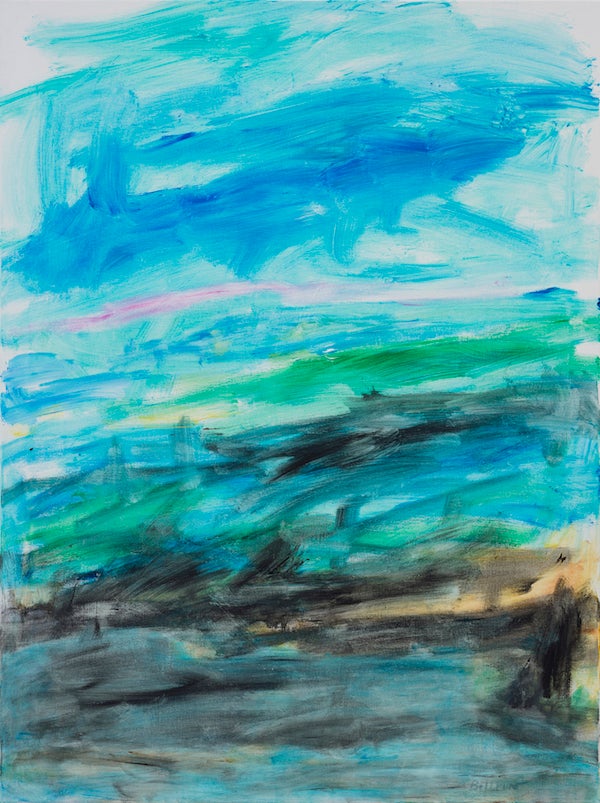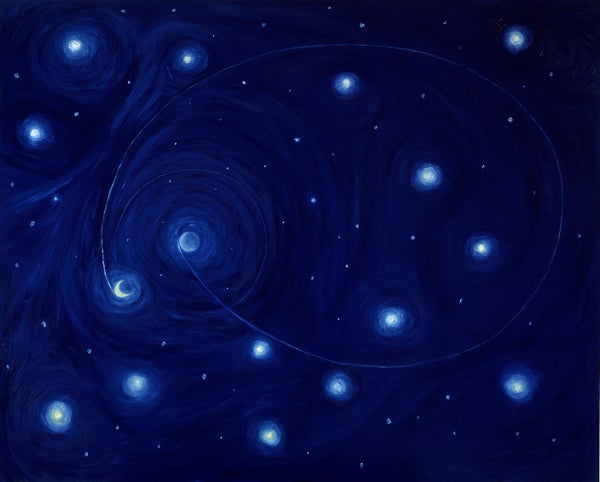This article was published in Scientific American’s former blog network and reflects the views of the author, not necessarily those of Scientific American
People talk a lot about the relationship between art and mathematics or science. Do they require the same thought process? Do they both use creativity the same way? These are intriguing questions, to say the least, and they’re particularly relevant to me because I’ve had the opportunity to develop two distinct careers—as a painter and as a mathematician and scientist.
I got started very young as an artist and did my first serious oil painting at seven years old (it was recently displayed at a gallery in New York) came instinctively to me. Without thinking about it, I could put pictures from my imagination onto a canvas, which was exciting—sort of like making dreams come true. There was a natural connection between my thoughts, no matter how vague, and their representation on the canvas.
My early paintings were often quite realistic, with easily recognizable scenes. Over the years, however, my creative energy has manifested itself in work that is more abstract and expressionistic, with fewer restrictions. I paint spontaneously, without any sketches. I’m almost continuously working in a purely creative mode.
On supporting science journalism
If you're enjoying this article, consider supporting our award-winning journalism by subscribing. By purchasing a subscription you are helping to ensure the future of impactful stories about the discoveries and ideas shaping our world today.
My experience in mathematics is much different. As a young boy I was never interested in math. It did not come easily to me—something that only began to change during my first year in college. Although I eventually found math fun, it was never as natural for me as art. Unlike painting, mathematics has strict rules. As I went on to get my doctorate in math from New York University’s Courant Institute of Mathematical Sciences, my field of specialization became theoretical celestial mechanics—how objects move through space.

Block Island, acrylic on canvas, 40 x 30 in. Credit: Edward Belbruno
Compared with, say, abstract expressionist painting, I experience relatively little creativity when doing mathematics or science. Yes, I need an insight to make a discovery, but insight is a mere instantaneous flash. After that eureka moment, the majority of my time is spent working hard to see it through, abiding by the rigid constraints of mathematical and scientific laws.
For example, while working at NASA’s Jet Propulsion Laboratory several decades ago, I realized, in a flash, how to find a radically new route to the moon that used a fraction of the fuel of the standard route. It took several years of hard work to verify this on the computer. The validity of the technique was finally demonstrated in 1991 in the rescue of a Japanese lunar spacecraft, Hiten, that had been launched into the wrong orbit.
When I’m doing an abstract expressionist painting, however, creative energy is ever present. There is no single eureka moment; I’m in eurekamode for the duration of the work. It is both exhilarating and exhausting. I also view the painting process as much more complex than working on a mathematical problem, not only because there are no laws that must be satisfied but because a painting has the dimensions of color and texture, which are subjective. And the end goal isn’t well defined, as in solving a mathematical or scientific problem.The creative process determines when the painting is finished, and there is no “correct” outcome. This is not to say there are no guidelines. When painting, I try to achieve a sense of balance, harmony and connection to the viewer, among other things.
Thus, doing a painting is very different from solving a math problem, from my perspective. Yet the two sometimes influence each other. It is well known that mathematics or science can inspire art, and it is also possible for art to inspire mathematics or science, leading to important insights not obtained by the usual methods. Leonardo da Vinci’s exquisite drawings revolutionized understanding of human anatomy, for example. And my idea for a fuel-efficient route to the moon came from a painting I did of the Earth-moon system (see my book Fly Me to the Moonfor a full explanation).
Needless to say, it took me years to learn how to balance my careers in art and mathematics. They have to be approached completely differently. When painting, I need to be completely freed up in my thoughts and deeply in touch with the creative energy that is to be expressed. When I solve a mathematics or science problem, my thinking needs to be much more constrained. The creative process can’t conflict with mathematical principles or the laws of nature. I almost have to be two people thinking two distinctly different ways.
There is more about these two kinds of creativity in the documentary Painting the Way to the Moon, whichwill screen at Agora Gallery in New York City on November 14, 2019, with a discussion between me and astrophysicist Neil deGrasse Tyson that may lead to some interesting insights. Some of my art will also be on display. You can get tickets here.
